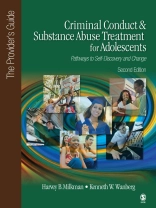This Provider′s Guide introduces a comprehensive and developmentally appropriate treatment program, Pathways for Self-Discovery and Change (PSDC), which provides the specific tools necessary for improving evaluation and treatment of at-risk youth, a particularly vulnerable patient population in the justice system. Using an adolescent-focused format, this protocol identifies psychological, biological, and social factors that contribute to the onset of adolescent deviance, and establishes guidelines for delivery of a 32-session treatment curriculum designed to rehabilitate both male and female adolescents with co-occurring substance abuse and criminal conduct.
Now in its Second Edition, this guide provides treatment practitioners, program evaluators, and youth services administrators with the most up to date, comprehensive, and accessible information for the treatment and rehabilitation of juvenile justice clients. It is built on theoretical and research advances in the treatment and rehabilitation of juvenile justice clients, as well as feedback over the past seven years from PSDC counselees, treatment providers, and program administrators.
SAGE offers treatment and training programs for mental health providers that you can easily incorporate into your existing programs.
Innehållsförteckning
List of Figures
List of Tables
Presentation Guidelines List of Tables
List of Reflection Poems
Acknowledgments
Introduction: Promoting Adolescent Resiliency
Section I: Theoretical and Research Perspectives
1. Adolescent Development and Pathways to Problem Behavior
2. Causes, Correlates, and Consequences of Adolescent Substance Abuse
3. Co-occurring Substance Abuse and Mental Disorder
4. Substance Abuse and the Adolescent Brain
5. Juvenile Crime and Violence
6. Addressing Gang Culture in the Context of Treatment
7. Female-Focused Treatment in the Juvenile Justice System
8. Youth Culture and Diversity
Section II: Foundational Treatment Models: Evidence-Based Approaches
9. Treatment Systems, Modalities, and Models of Care
10. The Cognitive-Behavioral Model and Core Treatment Strategies for Adolescents
11. Community Reintegration: Reinforcing Change Through Continuing Care
Section III: Operational Guidelines
12. Guidelines for the Assessment of Juvenile Justice Clients
13. Methods and Procedures for Program Delivery
Section IV: The Treatment Curriculum: Presentation Guidelines
14. Guidelines for Session Delivery: Pathways to Self-Discovery and Change (PSDC) Program Orientation
Section V: Adjunct Provider′s Guide for Treating Female Juvenile Justice Clients
15. Gender-Focused Session Enhancements
Appendices
References
Index
Om författaren
Kenneth W. Wanberg, Th D, Ph D, is a licensed psychologist in the State of Colorado and Director of the Center for Addictions Research and Evaluation, Inc.












